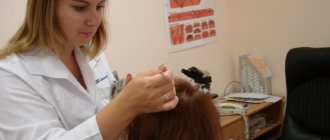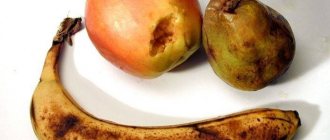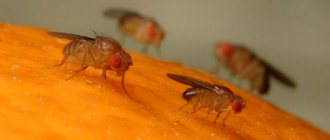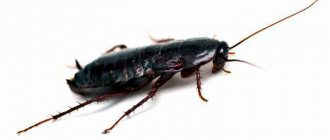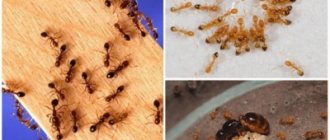Lice are unique arthropod insects whose life is directly related to the human body and blood. They live all over the world. The scientific name for lice is Anoplura. Lifespan is a little over a month. Lice are very difficult to get rid of, they multiply quickly, and their larvae cannot be destroyed with most modern drugs.
In Rus', it was believed that a person with a large number of lice on his head was very lucky and happy. And according to Slavic superstitions, lice dream of money and wealth.
Nowadays, few people would agree that having lice is a great happiness. On the contrary, these parasites are very feared, and the word “lice” does not have the most pleasant connotation. People infected with lice try to hide the symptoms and do not tell anyone about what happened. It is believed that these insects only live in the hair of people without a specific place of residence. But that's not true. In this article we will tell you in detail about the lifestyle of lice, where they come from, what troubles they can bring to a person, who most often gets them, as well as how to properly remove lice and nits at home using chemicals and folk recipes.
Appearance of lice
Lice are very small creatures, ranging in size from 0.4 to 5 mm, with a pronounced abdomen, but a small head and chest. The eyes are very small, vision is poor. Oriented by smell. Males are smaller than females. Surprisingly, lice have wings, but they are so small and atrophied that they are unable to fly.
The oral apparatus of lice is of the piercing-sucking type with a proboscis and two needles. When a louse feeds on blood, its proboscis extends from the head capsule and attaches itself to the puncture site of the skin. There are also hooks on the proboscis to securely fix the parasite on the victim’s body. When bitten, saliva is released, which prevents blood clotting and causes irritation and itching on the victim's skin.
Please note: lice cannot completely penetrate human skin. Only the proboscis penetrates the epidermis and pumps out blood.
Attachment to the hair is provided by tenacious and strong three pairs of legs with claws. Lice move at a speed of about 20 centimeters per minute. Lice attach their offspring in the form of nits (i.e. larvae) to the hair using a strong adhesive substance. The female can lay several hundred eggs, which will hatch in 4-16 days under comfortable conditions.
The main types of lice that a person can have - official names
There are many types of lice. There are more than 500 varieties of these parasites in mammals alone. Three can be found in a human home:
- Head louse;
- Cootie;
- Pubic louse.
Head louse
Pediculus humanus capitis is one of two species of human louse. This species lives on the hair of the head, as well as in the mustache and beard. The legs of the head louse are adapted to live on hair that has a circular cross-section.
The parasite's body is dark gray in color and small in size. A louse, settling in a person’s hair, feeds on his blood. After drinking blood, the color of the body changes to red or purple. The length of the adult parasite is 2-4 mm. Females usually have a larger body size. She lives for about 1 month, laying 5 eggs per day during this time. Eggs (nits) are attached to the base of the hair and mature in 7-10 days. After the grown louse leaves the egg, it is left hanging empty by a thread. 6-10 days after this, the young insect reaches sexual maturity.
Head louse is not as dangerous to humans as, for example, body louse. The fact is that she does not tolerate diseases such as typhus. However, after a parasite bite, saliva enters the wound, which causes itching and irritation (pediculosis). In this case, the likelihood of any infection entering through damaged areas of the skin increases.
Cootie
Pediculus corporis (or Pediculus humanus corporis De G. var. vestimenti) - this insect usually lives in the folds and pile of human clothing. This is where the louse reproduces and lays eggs (nits). Moving from clothing to skin for a while, the insect feeds on human blood. The body length of the female reaches 4.7 mm, the male – 3.7 mm.
The oral apparatus of lice consists of piercing needles enclosed in a soft tube (proboscis) that turns out of the mouth, the edges of which fit tightly to the pierced skin. The process of blood sucking occurs through muscle contractions of the pharyngeal pump and pharynx. The parasite's saliva contains an enzyme that prevents blood from clotting.
The short esophagus carries blood into the stomach, which can become very distended. An adult can drink from 0.001 to 0.003 ml. blood. Lice are sexually dimorphic, so females are often larger and heavier, so they drink more blood. Before being saturated with blood, the louse has a light gray tint. After the blood has entered the body of the parasite, the body acquires a dark red color.
Females live 40-45 days, during this period they manage to lay from 100 to 150 eggs . The female lays about 4 nits per day. A new nit turns into a louse in 6-8 days. During the first 8 days of life, the young parasite experiences 3 molts and can reproduce. This type of insect is dangerous to humans, as it is a carrier of typhus.
Pubic louse
This parasite is also called the flathead (lat. Phthirus pubis). They live on the human body in those areas where there is hair with a triangular cross-section, namely in the pubic area, on the genitals and around the anus. Sometimes pubic lice can be found in the armpits, on the chest and even on the stomach. The louse can never be found on the scalp, since these hairs have a round cut shape, and the limbs of the pubic louse are not adapted to attach to them.
The parasite feeds exclusively on human blood. Without new portions of blood, the insect dies within 24 hours . Having pierced the wall of a blood vessel, the insect expands the esophagus, drawing blood into itself like a pump. At the same time, she injects an enzyme into the wound that prevents blood clotting. The ploshchitsa feeds every 4-5 hours.
The insect's body usually has a light brown tint, making the parasite hardly noticeable on pubic hair. Body length is 1.5-2 mm, in larvae from 0.7 to 1 mm. With strong and large paws spread out, the louse may appear very wide. The color of the pubic louse is slightly brown.
The egg laid by the female develops in 5-7 days, the larva develops in about 13-17 days, and three moults occur during this period. After this, the adult begins to reproduce. The disease caused by the appearance of these parasites is called pediculosis pubis or phthiriasis.
Features of the life cycle of lice
Lice are extremely tenacious: they can easily withstand the low temperatures that a person finds themselves in, and with him they can stay under water for a long time. Evolutionarily, insect parasites have developed so much that nits, as their eggs are called, are much more resistant even to chemicals than adults, as well as larvae. With a special composition, they are firmly glued to a hair or thread of clothing, from where they are quite difficult to remove.
The lice's diet consists entirely of blood, which they suck, and the person feels itching on the skin from the bites. The insect lives for about 38 days, during which time the female lays about two hundred eggs. After a week, young individuals emerge and continue to develop.
These features of the life cycle of parasites are what we pay attention to when fighting them: lice are removed within a month. The more effective the drug and the more thorough the hair treatment, the faster you can get rid of lice and nits.
What do lice bites look like?
Even knowing what lice look like, it is not always possible to detect lice. Insects move quickly, and small white eggs can be difficult to notice on light-colored hair. Traces of insect bites can indicate the presence of lice in a child or adult. Most often they can be found in the back of the head and neck.
If there are multiple bites, various symptoms may appear. The main ones are:
- itching;
- burning;
- local redness;
- skin thickening;
- edema.
On a fresh bite you can see a hole - a puncture mark. The parasite secretes a special secretion into the wound that prevents blood clotting. Because of this, a person develops allergic reactions. This is especially pronounced on the sensitive skin of a child.
If there are a lot of lice, then red lice are found all over the head. They can merge into large formations. Around them, bluish or cyanotic spots form - subcutaneous hematomas. The blood in these areas comes close to the epidermis due to the bite.
Severe itching occurs at the site of the bite. The child has a desire to constantly scratch the affected area on the head. When an infection gets into the wound, an inflammatory process develops. In this case, pediculosis is accompanied by the appearance of a pustular rash.
Parasite bites look like small sores
Reproduction
A single mating of adults leads to complete insemination of all eggs of the female, who will be able to lay more than hundreds of nits over the rest of her life. Re-pairing is not required.
If just one fertilized female louse lands on a person's hair, after two weeks there may be 10 to 50 lice on the head.
Within a few hours after insemination, the female begins to lay eggs, attaching them to her hair, about 2-5 eggs per day.
Louse lays eggs on hair
After 7–11 days, the upper lid of the egg bursts and the nymph hatches. She begins to suck blood almost immediately after hatching, thanks to which she reaches adulthood in 8 days. If the louse does not find a food source, after about 18 hours it loses its ability to suck blood due to dehydration and dies.
What do body lice look like?
Blood-sucking insects that bite a person live not only on his body. Body lice live on bedding or in closets with clothes. They usually start due to poor personal hygiene. The ideal environment for such insects is unsanitary conditions. Body lice can feed on the blood of both adults and children.
This type of bloodsucker is smaller in size. The body structure is similar to the morphology of insects that parasitize the head. However, such a louse is more difficult to detect. This is directly related to their habitat. Both adult insects and their eggs are located on textile items: bed linen, clothing, towels.
The presence of lice is indicated by numerous bites all over the body. The red spots do not form clusters or chains, as happens with flea or bedbug bites. A characteristic rash appears on the abdomen, shoulders or other areas of the skin.
Pediculosis is easy to become infected with, so at the slightest suspicion, you should carefully check all family members. It is impossible to remove lice quickly. Numerous treatments with toxic drugs will be required. The process of combing dead insects out of long hair is often painful. In addition, personal belongings, furniture and clothing will need to be processed. Compliance with hygiene rules is the optimal prevention of head lice in adults and children.
Pediculosis refers to a parasitic skin disease caused by small insects - lice. In past years in the Russian Federation, various types of head lice were identified on average in 190 people per 100,000 population. In 2021, the incidence decreased by 13%. Despite this, lice continue to be found in representatives of various walks of life. Let's figure out what types of head lice pose a particular danger to humans.
What do they eat?
Lice feed exclusively on blood (mainly human), their oral apparatus is adapted specifically to pierce the skin and pump out blood. Other power sources are not available to them. They cannot feed on hair, skin or dandruff as some people believe.
Lice feed about 5 times a day every 2-3 hours. In one suction, a louse can drink approximately 0.5 mg of human blood. Saturation with blood allows parasites to reproduce and lead an active life.
Characteristics of the lice order
In Latin they are called Anoplura or Siphunculata . The main morphological characteristics of this order are as follows. An oval or oblong body that is flattened in the dorso-ventral direction. Body length 0.5-6 mm, width – 0.2-2 mm.
The body consists of a head, chest and abdomen. Three pairs of legs are attached to the chest, each with claws that hold the insect on the host's hair. Therefore, tearing a louse from a hair is quite difficult.
Many parasites do not have eyes at all, and in those who have them, the eyes are primitive pigment spots. Lice navigate in space not with the help of their visual organs, but with the help of their sense of smell.
A structural feature of this insect is its oral apparatus. Its basis is the proboscis, which has tenacious hooks, with which the louse clings to the skin of the owner. While sucking blood, the insect extends its proboscis, from which two sharp needles appear, with which the louse pierces the host’s skin, inserts the proboscis into the punctures and drinks blood.
Lice have well-developed salivary glands, and insect saliva contains special substances that prevent blood clotting. The bite is accompanied by itching, and you constantly want to scratch the puncture site.
How long do lice live and what causes them to die?
As mentioned earlier, the average lifespan of lice is 38 days . At the same time, a louse can go without food for 10 days if the ambient temperature is 10-20 degrees Celsius.
Lice die at elevated temperatures - from 44°C .
These parasites are able to survive in water for about two days , floating on the surface. This is how they are transmitted from person to person in the pool. Cold water is also not scary for them.
Lice cannot survive on a person's head if they are shaved bald. They will have nowhere to hide and secure offspring, and adult individuals will be immediately discovered and destroyed.
Some modern drugs can remove lice in one or two applications. We will talk about the choice of drugs below.
Diseases caused by lice and mites
There are a number of symptoms that allow you to recognize different types of “subcutaneous lice”. It is important not to confuse these parasites, since the methods of combating them differ.
Pediculosis
Lice come in head lice, body lice and pubic lice. The first live on the scalp, the second on clothing, and the third on the genitals. The first option is most common. Symptoms of head lice infestation are as follows:
- severe itching, causing you to constantly scratch your head and neck, resulting in characteristic abrasions;
- Red bite marks can be seen behind the ears, on the neck and scalp;
- There are nits on the hair - small white dots, grains that can be confused with dandruff. But, unlike her, they are well fixed, and you won’t be able to simply shake them off your head.
Thanks to special devices on the paws, lice can move very quickly along the surface of the hair.
Lice are transmitted by contact when an infected person is nearby, and the louse can crawl over. It is also possible for the parasite to come from the personal belongings of a person with pediculosis.
Scabies
Scabies mites, also known as scabies, cause a disease known as scabies.
Sometimes this is the name for any disease accompanied by severe itching, but true scabies is also accompanied by other symptoms:
- itching intensifies after a hot shower, as well as at night;
- a characteristic rash appears in the form of plaques, small pimples, or thin winding stripes with a vesicle at the end;
- you can notice a rash arranged in stripes - these are the passages that the female scabies mite gnaws under the top layer of skin. New itches are also born there.
Typically, the scabies mite affects areas with the thinnest skin: the bends of the joints, various folds, the surface between the fingers, the sides of the body.
Scabies is recognized by the presence of a rash and scabies, but in some cases the latter may not be present
In children, scabies most often appears in other places: on the face, scalp, palms and soles, and buttocks.
The tick that causes the disease is transmitted from person to person through close contact. Infection rarely occurs through personal belongings or bedding, but it still happens.
Read more about the scabies mite and treatment after its bite in our article: Scabies - from symptoms to prevention.
Based on data from skin and venereal disease clinics, statistics on the most typical places with scabies rash were collected.
Table: places most often affected by itching
| Percentage of infected people from the total number | Location of the rash |
| 50% | Wrists, area between fingers |
| 25% | Feet |
| 25% | Torso |
| 25% | Arms and legs (except hands and feet) |
| 50% men | Genitals |
| 10% women | Mammary gland |
Demodicosis
The disease is caused by an arthropod called demodex. Depending on the affected area, gland mites, or, as they are also called, acne gland mites, manifest themselves with the following symptoms:
- itching of the skin of the face, scalp;
- hair loss, fragility;
- the appearance of dandruff;
- pimples, pustules on affected areas;
- peeling of the skin, pink and red spots, increased fat secretion;
- when the eyes are infected with Demodex - discharge from them, lacrimation.
Unlike scabies, demodex lives deep in the skin. In this case, a person may experience pain and a feeling that something is crawling inside. Rarely, only with severe infection can glandular insects settle on the chest and upper back. Usually they affect the corners of the lips, nose, areas above the upper lip or on the chin, forehead, eyelids, cheeks, and less often the scalp.
The appearance of acne is a characteristic feature of destruction by the demodex mite.
Children, as a rule, do not get demodectic mange because their skin produces less of the mite-loved oil. Demodectic mange can only be contracted through close contact with a person who has quite a lot of iron mites.
Demodex often affects women who excessively use cosmetics, hair dyes and chemical personal care products, as all this disrupts the balance of the skin.
How to distinguish pediculosis from scabies and demodicosis
Lice and scabies infestations are quite easy to distinguish:
- with scabies there are no nits on the hair;
- when infested with lice, there is no rash;
- itching from lice does not intensify after taking a warm bath or shower, while this phenomenon is observed when infected with scabies mites.
It is also easy to distinguish between pediculosis and demodicosis:
- when affected by Demodex, there are also no nits;
- pimples appear, which do not occur from lice;
- like itching, glands affect the scalp less often than the face;
- Lice do not cause dandruff and hair loss.
One of the most common medicines for scabies and demodicosis is ordinary sulfur ointment.
Where do lice come from in humans?
Lice spread mainly through direct contact with an infected person, mainly in families, in kindergartens and schools, dormitories, and holiday camps; to a slightly lesser extent through various items: combs, brushes, hats, scarves, personal items and bedding. If lice get on the collar of your clothes, they can crawl onto the clothes of other people in shared lockers or changing rooms.
Lice can even be transmitted through pool water if an infected person has swam there. Lice are able to survive on the surface of the water for up to 2 days, waiting for a new victim.
Pubic lice are most often transmitted during sexual intercourse, less often when swimming in a pool, and body lice through clothing or underwear.
Who gets it most often?
Most often, lice appear on the hair of children 2 - 12 years old . The reason for the relatively easy transmission of lice in children in this age group is that children often touch their heads when playing games and do not bother to use personal hygiene products. A child can calmly dry himself with someone else’s towel or comb his hair with a friend’s comb.
Does the appearance of lice depend on the time of year?
As surprising as it may seem, in winter the incidence of head lice is higher than in other seasons. This is probably due to the fact that in winter they wear hats, and children often try on other people's hats. In the summer, haircuts are usually shorter, and there is much less clothing on which lice can spread.
Prevention
To protect yourself from infection, it is recommended to adhere to the following rules:
- avoid close contact with infected people;
- refuse casual sexual contacts;
- use only your own household items - combs, hairpins, scarves, etc.;
- change clothes regularly and wash them at high temperatures;
- carefully examine the scalp of yourself and your child;
- use special repellents if necessary;
- Apply anti-lice shampoos in small quantities from time to time.
You should not perceive lice as unpleasant but harmless bugs that can only cause itching at the bite sites . These blood-sucking parasites can carry severe infectious diseases, provoke allergies and cause rough skin. Lice must be dealt with immediately as soon as insects or their metabolic products are noticed.
- about the author
- VK profile
How can you tell if you have lice?
Symptoms indicating the appearance of lice on the head:
- Itching that gets worse at night.
- Pink spots on the scalp with a small red dot in the middle are signs of lice bites.
- Small beige or white “pebbles” on the hair are nits. Fixed very tightly. The presence of nits indicates that the lice infection occurred several days or even a week ago. They cannot be crushed and are quite difficult to tear off from the hair.
Symptoms of infection
Signs of infection are:
- presence of bites on the scalp;
- severe itching in the ears, temples, and back of the head;
- swollen lymph nodes;
- the presence of crusts on the scalp;
- nervousness and constant anxiety.
If there are nits on a person’s hair, an unpleasant smell from the hair, tangling, and even the formation of tangles are noted.
Signs of body lice infestation are as follows:
- itching, urticaria;
- the appearance of bluish spots on the skin;
- in severe cases, the temperature may rise and headaches may appear.
Signs of pubic lice:
- itching;
- hemorrhage at the site of the lesion;
- With sensitive skin, blisters may appear;
- traces of vital activity on underwear.
How to get rid of lice?
Pediculosis will not go away on its own. Over time, the number of insects increases, the number of bites increases, and the itching becomes constant and unbearable. Control methods are divided into two types - mechanical and chemical. Folk recipes can also be classified as chemical methods, but we will consider them separately.
Mechanical methods
Typically, mechanical methods mean hair cutting, shaving and combing out parasites with a comb, but they can also include thermal treatment with a hair straightener or tongs. Hair cutting at the root is the cheapest and most effective treatment method, but it is not suitable for everyone. Women and girls will not want to lose their hair, and not all men are ready to go bald.
Chemical and mechanical methods must be combined. Just treating with a drug from a pharmacy will not be enough; you need to comb out dead lice and their larvae from your hair. The fact is that most drugs are not capable of destroying nits; their shell reliably protects the offspring from chemical exposure.
Don't expect to get by with a regular comb. Nits must be combed out with a special comb with very frequent teeth located almost close to each other.
Chemicals
There are a large number of modern drugs for head lice; they differ in cost, consistency and method of application. The most common types of medicinal formulations can be distinguished:
- Shampoos are the most popular, inexpensive and quite effective products when used correctly and following all the procedures specified in the instructions. Here are some of them: Hygia, Paranit, Lavinal. Shampoos specifically designed for children are sold separately.
- Sprays are more effective than shampoos, but are more difficult to use, are difficult to wash off and can cause unwanted allergic reactions. Usually a comb is included. The most famous: Paranit, Lavinal, Nyuda, Para Plus.
- Aerosols used to treat contaminated clothing. Someone even uses Dichlorvos against lice.
- Creams are less common than shampoos and sprays, but they are not inferior to sprays in effectiveness. Among them: Nix, D-95.
- Combs - designed for combing out bloodsuckers. They differ from ordinary ones in that they have very frequent teeth that detach the nit from the hair using mechanical pressure. But this is an auxiliary product used in combination with chemicals, most often included with the product.
Linen lice are removed by thoroughly washing and ironing bedding or clothing. Temperatures above +60 and below -10 °C are destructive for parasites.
Traditional methods
Although folk remedies can be recommended by most representatives of the older generation, they cannot be called particularly effective. Their main advantage is accessibility, but they can cause harm or, at the very least, be useless. Here are some common folk remedies for lice and nits.
- Kerosene - smear it on your head, wrap it around your hair and leave it for 2 hours. After treatment, the substance must be washed out for a very long time, besides, it damages the hair and can leave a chemical burn on the scalp.
- Cranberry juice has a depressant effect on lice and detaches nits from the hair, as the acid dissolves the adhesive. All that remains is to comb them out with a fine comb.
- Vinegar 6 or 9% acts similar to cranberry juice. Take three tablespoons of vinegar per 300 ml of water and apply the mixture to the scalp. The composition dries out the scalp greatly.
- A mixture of pomegranate juice and mint decoction, in a ratio of 1 glass to 3 tablespoons, is boiled for more than 10 minutes. Moisten the hair with a warm decoction and rub it into the skin.
- Hair coloring will not prevent lice. Only very caustic and harmful paint can kill 40-80% of parasites. This method cannot be considered effective
All folk remedies involve wrapping the head in a towel for up to two hours. But in children it is necessary to check the condition of the skin every 30–40 minutes to avoid burns.
We do not recommend resorting to traditional recipes if it is possible to purchase a safe and effective medicine at the pharmacy.
Stages of lice removal
It is better to first destroy adult insects and nymphs, and then nits. Shampoos and sprays usually contain combs in the package, which should be used to comb out lice and nits after treating the head. If the infection process has just begun, they are combed out within three to five days. Combs with long rather than short teeth give quick results.
If after one wash with an insecticidal agent and combing the insects survive, you should treat your hair again after a week. And comb out again, since initially some nits may not be combed, and larvae will hatch from them.
Carefully study the composition of the drug, pay attention to contraindications, check in advance for an allergic reaction on the skin of the elbow. Follow the rules of use described in the instructions. And best of all, consult a doctor before starting treatment!
Prevention of lice is to follow the rules of hygiene: use only your own things, swim in the pool with a cap and avoid untidy people.
Treatment
In order to recover, of course, it is advisable to seek professional help from a doctor. However, if you are 100% sure that it is lice that are bothering you, you can get rid of it yourself. It's very simple. Previously, these insects were poisoned with kerosene, and the infected hair was shaved.
Today, more effective methods have appeared: for the economical - 10% or 5% sulfur ointment or ointment with benzyl benzoate, for the rest - "Nittifor", "Spray-Pax" or Spregal. The method of use is described in the instructions.
After treatment is completed, all underwear and bedding should be soaked in bleach or boiled, then ironed with a hot iron. Remember that for lice pubis, all sexual partners need to be treated at the same time.
Characteristics of lice
So, what do human lice look like (look at the photo), what are the features of their behavior? How to distinguish between lice and nits?
The photo shows that a parasite dangerous to humans, the head louse, is light gray in color, has 6 legs and antennae, an abdomen, a cephalothorax, and body segments.
The size of lice is only 3 millimeters, they move, as already noted, very quickly, so it is not at all easy to see lice with the naked eye.
Much more noticeable are their eggs - nits. The size of nits is also tiny - 1.5 millimeters, but they are brighter in color (white) and immobile.
Nits are firmly attached to the roots of the hair, at a distance of no more than 6 centimeters from the skin.
You can confuse nits with severe dandruff, but, unlike the latter, it is almost impossible to shake nits from the hair, the eggs are so well attached to the hairs (look at the photo).
Pediculosis is a disease that spreads unusually quickly: it’s enough for one lice to get on a person’s hair, and within a few days there will be 10 of them.
So, every day a female lice leaves 10 - 12 eggs. After 2-3 days, lice eggs turn into larvae, which grow and mature within 2 weeks.
When lice reach sexual maturity, the parasites begin to mate.
Thus, the period of birth and development of lice is about 20 days; at low temperatures, the development time of lice and nits increases to 30 days.
Pay attention to the photo: lice, nits (lice eggs), larva. In 95% of cases, both lice and their eggs - nits - are located and live on the head, on human hair (it’s not for nothing that lice are called “head lice”)
In 95% of cases, both lice and their eggs - nits - are located and live on the head, on human hair (it’s not for nothing that lice are called “head lice”).
However, it happens that these harmful insects infest people’s eyebrows and even eyelashes - there are many similar messages and photos on forums.
For normal life, a human louse must feed at least 3 times a day (lices only eat blood).
To get the food they need, lice pierce the scalp, during which saliva is released, and the person feels severe itching.
So, we found out what lice and nits look like on a person’s head and hair.
Video:
To remember even better, you can view several enlarged images of lice in the photo, and if the photo is not enough, watch a video on the Internet demonstrating lice and nits on the hair and, finally, turn to the help of a microscope.
It is equally important to know how head lice are transmitted in order to protect yourself and your child.
Where do lice come from?
The appearance of lice is often recorded in people who spend some time en masse in confined spaces, especially in:
- Children's educational institutions
- Summer camps
- Prisons and pre-trial detention centers
- Hostels and rooming houses where sanitary standards are not observed
But where do lice come from if you do not have any points of contact with the above institutions? Lice are transmitted through tactile contact or through the belongings of a person infected with lice, so you can become infected with these parasites:
- Trying on clothes in a store
- Touching handrails, seats and other people on public transport
- Visiting a pool, fitness club, or public beach
- Using other people's combs and towels
- Using someone else's bed linen
Thus, absolutely anyone can accidentally pick up lice, regardless of their lifestyle and surrounding conditions.

